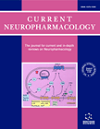- Home
- A-Z Publications
- Current Neuropharmacology
- Previous Issues
- Volume 6, Issue 4, 2008
Current Neuropharmacology - Volume 6, Issue 4, 2008
Volume 6, Issue 4, 2008
-
-
Selective Serotonin Reuptake Inhibitors: A Review of its Effects on Intraocular Pressure
More LessAuthors: Ciro Costagliola, Francesco Parmeggiani, Francesco Semeraro and Adolfo SebastianiThe increase in serotonin (5-HT) neurotransmission is considered to be one of the most efficacious medical approach to depression and its related disorders. The selective serotonin reuptake inhibitors (SSRIs) represent the most widely antidepressive drugs utilized in the medical treatment of depressed patients. Currently available SSRIs include fluoxetine, sertraline, paroxetine, fluvoxamine, citalopram and escitalopram. The p Read More
-
-
-
Tianeptine: An Antidepressant with Memory-Protective Properties
More LessAuthors: Phillip R. Zoladz, Collin R. Park, Carmen Munoz, Monika Fleshner and David M. DiamondThe development of effective pharmacotherapy for major depression is important because it is such a widespread and debilitating mental disorder. Here, we have reviewed preclinical and clinical studies on tianeptine, an atypical antidepressant which ameliorates the adverse effects of stress on brain and memory. In animal studies, tianeptine has been shown to prevent stress-induced morphological sequelae in the hippocampus Read More
-
-
-
Dopaminergic and Noradrenergic Contributions to Functionality in ADHD: The Role of Methylphenidate
More LessAuthors: Veronika Engert and Jens C. PruessnerAttention Deficit Hyperactivity Disorder (ADHD) is a childhood psychiatric condition characterized by severe impulsiveness, inattention and overactivity. Methylphenidate (MPH), a psychostimulant affecting both the dopaminergic and the noradrenergic systems, is one of the most frequently prescribed treatments for ADHD. Despite the widespread use of MPH and its proven effectiveness, its precise neurochemical Read More
-
-
-
Activity-Dependent Release of Adenosine: A Critical Re-Evaluation of Mechanism
More LessAuthors: Mark Wall and Nicholas DaleAdenosine is perhaps the most important and universal modulator in the brain. The current consensus is that it is primarily produced in the extracellular space from the breakdown of previously released ATP. It is also accepted that it can be released directly, as adenosine, during pathological events primarily by equilibrative transport. Nevertheless, there is a growing realization that adenosine can be rapidly releas Read More
-
-
-
Triple Reuptake Inhibitors: The Next Generation of Antidepressants
More LessAuthors: David M. Marks, Chi-Un Pae and Ashwin A. PatkarDepression has been associated with impaired neurotransmission of serotonergic, norepinephrinergic, and dopaminergic pathways, although most pharmacologic treatment strategies for depression enhance only serotonin and norepinephrine neurotransmission. Current drug development efforts are aimed at a new class of antidepressants which inhibit the reuptake of all three neurotransmitters in the hope of creating med Read More
-
-
-
Pharmacology and Therapeutic Potential of Sigma1 Receptor Ligands
More LessAuthors: E. J. Cobos, J. M. Entrena, F. R. Nieto, C. M. Cendan and E. D. PozoSigma (σ) receptors, initially described as a subtype of opioid receptors, are now considered unique receptors. Pharmacological studies have distinguished two types of σ receptors, termed σ1 and σ2. Of these two subtypes, the σ1 receptor has been cloned in humans and rodents, and its amino acid sequence shows no homology with other mammalian proteins. Several psychoactive drugs show high to moderate affinity fo Read More
-
-
-
Neurophysiology of Sleep and Wakefulness: Basic Science and Clinical Implications
More LessAuthors: Jonathan R.L. Schwartz and Thomas RothIncreased attention to the prevalence of excessive sleepiness has led to a clear need to treat this symptom, thus reinforcing the need for a greater understanding of the neurobiology of sleep and wakefulness. Although the physiological mechanisms of sleep and wakefulness are highly interrelated, recent research reveals that there are distinct differences in the active brain processing and the specific neurochemical sys Read More
-
-
-
Neuropharmacological Mechanisms Underlying the Neuroprotective Effects of Methylphenidate
More LessBy T. J. VolzMethylphenidate is a psychostimulant that inhibits the neuronal dopamine transporter. In addition, methylphenidate has the intriguing ability to provide neuroprotection from the neurotoxic effects of methamphetamine and perhaps also Parkinson's disease; both of which may likely involve the abnormal accumulation of cytoplasmic dopamine inside dopaminergic neurons and the resulting formation of dopamine-associated Read More
-
Volumes & issues
-
Volume 23 (2025)
-
Volume 22 (2024)
-
Volume 21 (2023)
-
Volume 20 (2022)
-
Volume 19 (2021)
-
Volume 18 (2020)
-
Volume 17 (2019)
-
Volume 16 (2018)
-
Volume 15 (2017)
-
Volume 14 (2016)
-
Volume 13 (2015)
-
Volume 12 (2014)
-
Volume 11 (2013)
-
Volume 10 (2012)
-
Volume 9 (2011)
-
Volume 8 (2010)
-
Volume 7 (2009)
-
Volume 6 (2008)
-
Volume 5 (2007)
-
Volume 4 (2006)
-
Volume 3 (2005)
-
Volume 2 (2004)
-
Volume 1 (2003)
Most Read This Month
Article
content/journals/cn
Journal
10
5
false
en


